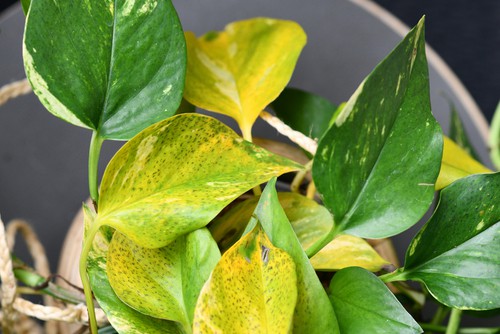Pothos plants are a popular choice among indoor gardeners due to their low-maintenance nature and aesthetic appeal. However, one issue that can arise with these plants is the development of brown spots on their leaves.
These unsightly brown spots on leaves pothos can be concerning to plant owners, but they are typically a sign of an underlying issue that can be addressed with proper care.
Identifying the cause of brown spots on pothos leaves is the first step in addressing the issue. Common causes include overwatering, exposure to direct sunlight, nutrient deficiencies, and pests or diseases.
By examining the plant and taking note of any other symptoms, such as yellowing or wilting, it is possible to narrow down the cause and take appropriate action.
Preventing brown spots on pothos leaves involves maintaining a consistent care routine that includes proper watering, fertilization, and light exposure. If brown spots do develop, treatment options include adjusting the care routine, pruning affected leaves, and using natural or chemical treatments to address pests or diseases.
By taking a proactive approach to pothos care, plant owners can enjoy healthy, vibrant plants without the worry of unsightly brown spots on their leaves.
Key Takeaways
- Brown spots on pothos leaves can be a sign of an underlying issue that can be addressed with proper care.
- Common causes of brown spots include overwatering, exposure to direct sunlight, nutrient deficiencies, and pests or diseases.
- Preventing brown spots involves maintaining a consistent care routine and taking appropriate action if brown spots do develop.
Related posts:
- Brown Spots on Leaves of Peace Lily
- Brown Spots on Leaves of Fiddle Leaf Fig
- Brown Spots on Kalanchoe Leaves
Identifying Brown Spots on Pothos Leaves
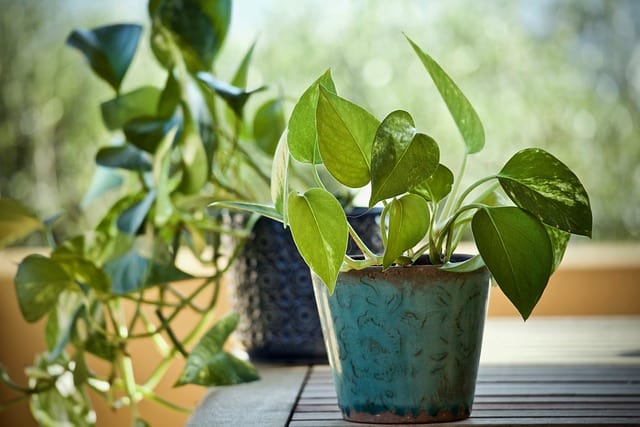
Pothos is a popular houseplant that is easy to care for and can thrive in a variety of environments. However, like any plant, it can develop issues, including brown spots on the leaves. These spots can be caused by a variety of factors, including environmental conditions, pests, and diseases.
1. Environmental Conditions
One of the most common causes of brown spots on pothos leaves is environmental conditions. If the plant is exposed to direct sunlight or hot, dry air, the leaves can become dry and brown. Additionally, if the humidity is too low, the edges of the leaves can turn brown.
2. Pests
Pests can also cause brown spots on pothos leaves. Spider mites, mealybugs, and scale insects can all feed on the leaves, causing damage that appears as brown spots.
3. Diseases
Brown spots on pothos leaves can also be a sign of disease. Bacterial leaf spot and fungal infections can both cause brown spots on the leaves. Bacterial leaf spot typically appears as water-soaked spots that turn brown and can eventually cause the leaves to drop off. Fungal infections can cause brown spots with yellow halos.
4. Rust
Another possible cause of brown spots on pothos leaves is rust. Rust is a fungal disease that appears as small, rust-colored spots on the leaves. Over time, the spots can grow and merge, causing the leaves to turn brown and fall off.
Brown Spots on Leaves Pothos – 4 Common Problems
Pothos plants are known for their lush green leaves, but sometimes they can develop brown spots that detract from their beauty. There are several reasons why brown spots might appear on pothos leaves, and it’s important to identify the cause so that you can take the appropriate action.
1. Watering Issues

One of the most common causes of brown spots on pothos leaves is watering issues. If the plant is overwatered or underwatered, it can develop brown spots.
Overwatering can lead to root rot, which can cause the leaves to turn brown and wilt. Underwatering, on the other hand, can cause the leaves to dry out and develop brown spots.
2. Humidity and Temperature
Pothos plants prefer high humidity levels, and if the air is too dry, the leaves can develop brown spots. Similarly, if the temperature is too cold or too hot, the leaves may turn brown. It’s important to keep the plant in a location where the temperature is between 60 and 85 degrees Fahrenheit and to maintain a humidity level of at least 40%.
3. Light and Soil
Direct sunlight can cause pothos leaves to turn brown, especially if the plant is exposed to it for an extended period of time. Pothos plants prefer bright, indirect light, so it’s best to keep them away from windows that receive direct sunlight. Additionally, if the soil is too dry or too wet, the leaves can develop brown spots.
4. Fertilizer and Disease
Over-fertilizing can cause mineral salt buildup in the soil, which can lead to brown spots on pothos leaves. It’s important to fertilize the plant sparingly and only when necessary.
In addition, pothos plants can be susceptible to disease, which can cause brown spots on the leaves. If you suspect that your plant has a disease, it’s important to take action quickly to prevent it from spreading.
Overall, there are several factors that can cause brown spots on pothos leaves, including watering issues, humidity and temperature, light and soil, fertilizer, and disease. By identifying the cause of the brown spots, you can take the appropriate action to keep your pothos plant healthy and beautiful.
Impact of Pests and Diseases
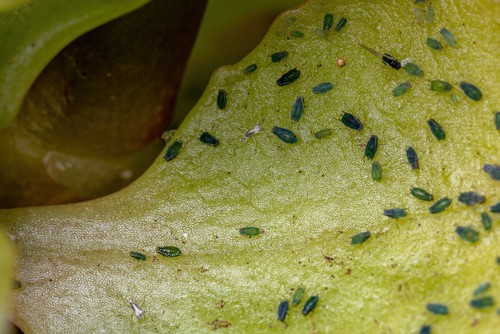
Pests and diseases can have a significant impact on the health of pothos plants, leading to the development of brown spots on leaves. Insects such as spider mites, mealybugs, and aphids can cause brown spots on pothos leaves by feeding on the plant’s sap. These pests can also ruffle and distort the leaves, making them unsightly.
Insect infestations can be treated by using insecticidal soap or neem oil. These treatments can be applied to the leaves and stems of the plant to kill the pests and prevent further infestation. It is essential to follow the instructions on the product label carefully to avoid damaging the plant.
Bacterial infections can also cause brown spots on pothos leaves. These infections can be caused by overwatering or poor drainage, which can lead to root rot. The bacteria can spread from the roots to the leaves, causing them to turn brown.
To prevent bacterial infections, it is essential to ensure that the soil is well-draining and that the plant is not overwatered. If the plant is infected, it is best to remove the affected leaves and treat the plant with a fungicide.
Pest infestations and bacterial infections can weaken the plant and make it more susceptible to other diseases. It is essential to monitor the plant regularly for signs of infestation or infection and take action promptly to prevent further damage.
Role of Care Routine in Preventing Brown Spots
Pothos is a low-maintenance houseplant that can thrive in a variety of conditions. However, brown spots on the leaves can be an indication that the plant is not receiving proper care. Here are some tips on how to prevent brown spots on pothos leaves:
1. Watering Issues
Overwatering or underwatering can lead to brown spots on the leaves. Pothos prefers moist soil, but it should not be watered excessively. It is important to adjust your watering schedule based on the plant’s needs and the environment it is in.
One way to check if the plant needs water is to stick your finger about an inch into the soil. If it feels dry, it’s time to water.
2. Soil and Fertilizer
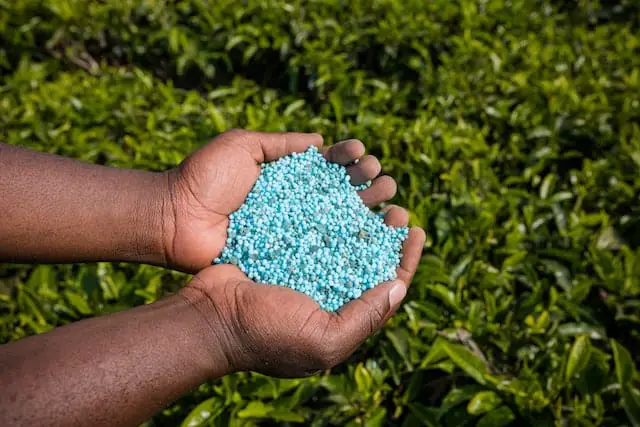
Pothos prefers well-draining soil that is rich in nutrients. It is important to use a high-quality potting mix that allows for proper drainage. Fertilizer should be applied sparingly, as over-fertilizing can lead to brown spots on the leaves. A balanced fertilizer can be applied every two to four weeks during the growing season.
3. Humidity and Temperature
Pothos prefers high humidity levels, so it is important to provide adequate moisture. One way to increase humidity is to place a tray of water near the plant or use a humidifier. Pothos also prefers temperatures between 60 and 85 degrees Fahrenheit.
4. Root Rot and Stems
Root rot can be a common issue with pothos if the plant is overwatered or the soil does not drain properly. If root rot is present, the leaves may turn yellow or brown and fall off. It is important to inspect the roots and remove any that are brown or mushy. Stems that are brown or mushy can also indicate overwatering or root rot.
5. Rest and Care Routine
Pothos does not require a lot of maintenance, but it is important to provide proper care. The plant should be allowed to rest during the winter months, as growth slows down during this time.
It is important to keep the plant in a well-lit area, but out of direct sunlight. Regularly inspecting the plant for any signs of pests or disease is also important in preventing brown spots on the leaves.
Treatment Options for Brown Spots
When it comes to treating brown spots on pothos leaves, there are several options available. The best treatment option depends on the cause of the brown spots. Here are some common treatment options for brown spots on pothos leaves:
1. Fungus and Bacterial Infections
Fungal and bacterial infections are common causes of brown spots on pothos leaves. To treat these infections, it is essential to identify the specific fungus or bacteria causing the problem.
Once identified, a suitable fungicide or bactericide can be used to treat the infection. It is important to follow the instructions on the product label carefully. In severe cases, pruning affected leaves may be necessary.
2. Lack of Humidity
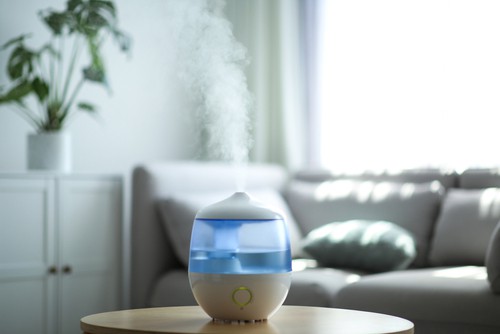
Pothos plants thrive in humid environments. If the air is too dry, brown spots may appear on the leaves. To remedy this, misting the plant with water can help increase humidity levels. Alternatively, placing a tray of water near the plant can also help increase humidity levels.
3. Nutrient Deficiencies
Nutrient deficiencies can cause brown spots on pothos leaves. To treat this, it is essential to feed the plant with a suitable fertilizer. It is important to follow the instructions on the product label carefully. Over-fertilization can also cause brown spots, so it is important not to overfeed the plant.
4. Pests
Pests such as spider mites and mealybugs can cause brown spots on pothos leaves. To treat this, it is essential to identify the specific pest causing the problem. Once identified, an insecticidal soap or neem oil can be used to treat the infestation. It is important to follow the instructions on the product label carefully.
5. Environmental Factors
Environmental factors such as cold temperatures and harsh light sources can cause brown spots on pothos leaves. To remedy this, it is essential to provide the plant with suitable environmental conditions. This may involve moving the plant to a warmer location or away from harsh light sources.
6. Rubbing Alcohol
Rubbing alcohol can be used to treat brown spots caused by bacterial infections. To use this remedy, dip a cotton swab in rubbing alcohol and gently rub it on the affected areas. It is important not to overuse this remedy, as it can damage the plant.
7. Repotting
Repotting can help treat brown spots caused by root rot or other issues related to the soil. When repotting, it is important to use a suitable potting mix and to ensure that the plant has adequate drainage.
Preventive Measures Against Brown Spots
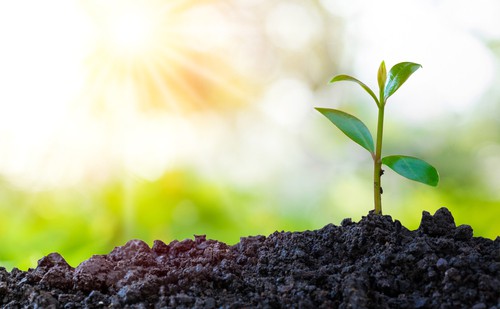
Pothos is a popular houseplant that is easy to care for and can thrive in a variety of conditions. However, brown spots on the leaves can be a common issue that many plant owners face. Fortunately, there are several preventive measures that can be taken to minimize the occurrence of brown spots on pothos leaves.
1. Watering
One of the most common causes of brown spots on pothos leaves is improper watering. Overwatering or underwatering can lead to stress on the plant, causing brown spots to appear.
To prevent this, it is essential to establish a consistent watering schedule. Pothos plants prefer to be kept slightly moist, but not too wet. It is important to ensure that the soil is allowed to dry out slightly between watering sessions. Additionally, ensure that the pot has proper drainage holes to avoid waterlogging.
2. Light
Pothos plants prefer bright, indirect light. Direct sunlight can cause the leaves to burn and develop brown spots. Conversely, low light conditions can cause the leaves to yellow and drop off.
It is essential to place the plant in a location with filtered light that receives adequate airflow. If the plant is placed near a window, ensure that it is not exposed to direct sunlight.
3. Humidity
Pothos plants thrive in high humidity environments. Low humidity levels can cause the leaves to dry out and develop brown spots. To increase humidity levels, mist the plant regularly or place a tray of water near the plant. Alternatively, consider placing the plant in a room with a humidifier.
4. Fertilizer
Over-fertilizing can lead to fertilizer burn, causing brown spots to appear on the leaves. It is essential to follow the recommended dosage of fertilizer and avoid fertilizing the plant during winter months when it is dormant.
5. Pruning
Regular pruning can help prevent the occurrence of brown spots on pothos leaves. Remove any dead or yellowing leaves, as they can attract insects and lead to infestations. Additionally, pruning can help promote new growth and maintain the plant’s shape.
Conclusion

In conclusion, brown spots on pothos leaves can be caused by a variety of factors, including disease, improper care, and pests. It is important to identify the cause of the brown spots and take the appropriate steps to remedy the issue.
One common cause of brown spots on pothos leaves is overwatering, which can lead to root rot and fungal infections. To prevent overwatering, adjust your watering schedule and ensure that your pothos plant has proper drainage.
In addition, avoid using tap water, which can contain high levels of fluoride and salt that can damage pothos leaves.
Another common cause of brown spots on pothos leaves is too much direct sunlight. Pothos plants prefer indirect light, so it is important to place them in a location with filtered light or in a room with low to medium light levels. In addition, make sure your pothos plant is not exposed to cold drafts or excessively hot temperatures.
Bacterial leaf spot and other leaf spot diseases can also cause brown spots on pothos leaves. To treat these infections, isolate the affected plant and treat it with a fungicide or bactericide. In addition, adjust your care routine to prevent future infections, such as increasing air circulation and avoiding overhead watering.
Pests such as spider mites, mealybugs, and scale insects can also cause brown spots on pothos leaves. To treat pest infestations, prune affected foliage and treat the plant with neem oil or insecticidal soap. In addition, mist the plant regularly to increase humidity levels and discourage pests.
Overall, by identifying the cause of brown spots on pothos leaves and taking appropriate measures to remedy the issue, you can ensure that your indoor plant remains healthy and vibrant.
Frequently Asked Questions
How do you treat brown spots on pothos?
Treating brown spots on pothos leaves depends on the underlying cause. If the brown spots are due to overwatering, adjust the watering schedule and allow the soil to dry out before watering again.
If the brown spots are due to fungal or bacterial infections, apply a fungicide or bactericide according to the manufacturer’s instructions. If the brown spots are due to pests, use an appropriate insecticide to eliminate the infestation.
Can you cut the brown spots off of pothos leaves?
Yes, you can cut off the brown spots on pothos leaves. Use a clean, sharp pair of scissors or pruning shears to remove the affected leaves or parts of the leaves. Make sure to sterilize your cutting tools before and after use to prevent the spread of disease.
Why are my plant leaves getting brown spots?
Plant leaves can develop brown spots due to a variety of reasons, including overwatering, underwatering, pests, fungal or bacterial infections, nutrient deficiencies, or environmental stress. Identifying the underlying cause is crucial to treating and preventing brown spots on plant leaves.
What are the fungal spots on pothos leaves?
Fungal spots on pothos leaves are caused by various fungal diseases, including leaf spot, anthracnose, and powdery mildew. These diseases can cause brown or black spots on the leaves, as well as yellowing, wilting, and leaf drop.
To treat fungal spots on pothos leaves, apply a fungicide according to the manufacturer’s instructions.
What causes white spots on pothos leaves?
White spots on pothos leaves are usually caused by scale insects or mealybugs. These pests feed on the sap of the plant and secrete a sticky substance called honeydew, which can attract fungal growth and cause further damage to the plant.
To treat white spots on pothos leaves, use an appropriate insecticide to eliminate the infestation.
Why are my pothos leaves turning brown?
Pothos leaves can turn brown due to various reasons, including overwatering, underwatering, pests, fungal or bacterial infections, nutrient deficiencies, or environmental stress. Identifying the underlying cause is crucial to treating and preventing brown spots on pothos leaves.

Hey, I’m Lisa and I’ve been an avid gardener for over 30 years. I love writing, talking and living in the garden! Feel free to connect with me on my socials below

